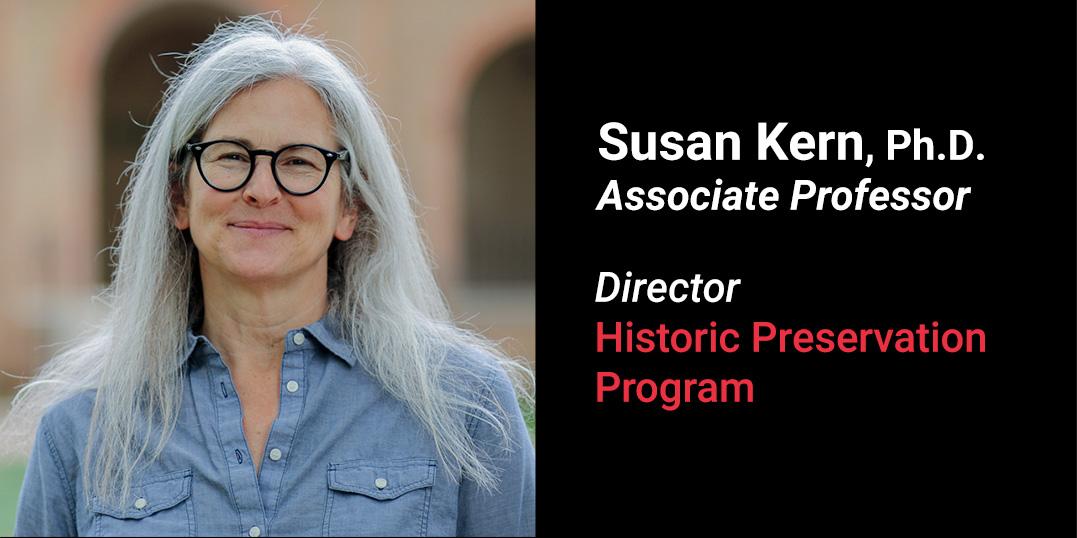Susan Kern serves as the director of the Historic Preservation Program. She received her Ph.D. in History from William & Mary and her M.A. in Architectural History from the University of Virginia. In between degrees, she worked in the archaeology department at Monticello and directed field research.
Kern formerly served as the Director of Historic Campus at William & Mary and taught history, material culture and museum studies courses in the history department.
Read more about Kern's background.
To Susan Kern, historic sites and buildings embody the human experience. Whether it's on a local or global level, they tell a story that touches every area of human life.
"I remember vividly when I was a senior in college, and I took one course in architectural history. It was exactly what I had been looking for because buildings are the history of technology, aesthetics, fashion, economics and social movements," Kern said. "I finally found the history of everything."
Kern's professor helped her find her way to graduate school to study architectural history at the University of Virginia which started her career in the field and historic preservation. She didn't fully understand the relationship between architectural history and historic preservation at that time. To many people, they are the same thing. And to some people, they're different. But to Kern, it's all part of the same work.
"To me, it's all part of why a place matters because places form and reflect our lives,” Kern said. “Enabling people to see what’s around them is one of the big issues I engage with as someone whose history work is also public-facing. I have to argue why it matters, and the public doesn't always know why a rural piece of land they're stuck next to in a traffic jam is important."
Kern has had the great fortune of living where people tend to be history-minded and value living close to history. She grew up around Philadelphia, where she says people are used to talking about Independence Hall and Valley Forge. She also lived in Charlottesville and Williamsburg.
That background has contributed to and carried over into her professional work where she began her career in the archaeology department of Monticello. Monticello is the home and plantation Thomas Jefferson owned.
While there, she conducted research looking for lost buildings and lost landscapes at Shadwell, Jefferson’s birthplace, which was also home to the largest population of enslaved people in colonial Albemarle County.
She discovered how to utilize tools to decipher the past and understand the public role of historic preservation, buildings and landscapes. She spent the next five years at Monticello and became acting director of the archaeology department. Then, she took her research to write her dissertation and her first book.
Kern said Shadwell was the most intriguing project she's ever worked on because of the opportunity to study an entire plantation through its material culture and social history.
“The site had been excavated in the 1940s and 1950s, and the archaeologists then felt the evidence was inconclusive about what the Jefferson's house looked like,” Kern said. “The earlier research worked at the beginning of the preservation movement. We brought tools developed since that included understanding vernacular landscapes and material evidence from people who didn’t leave written records."
The biggest discovery from studying Shadwell was uncovering the untold stories and histories of people not named Jefferson who lived there.
"There were about 31 enslaved people who lived on that site and about ten Jefferson family members, as well as another 30 enslaved people on outlying farms," Kern said. "The potential to expose stories of people and their families who I didn't expect to get to know through that historic site was one of the great revelations.”
Kern studied artifacts and records to uncover the movement of people and goods across colonial Virginia. These networks revealed some ways that place connected enslaved people to Black and white families before and after coming to Shadwell.
"To be able to do that felt special and rare and important," Kern said. "It was the part of the site that we didn't necessarily know we were going to be able to recover a lot of history from, which launched me to ask new questions."
In addition to her own published work on Shadwell, she wrote a new state highway marker for the site, contributed to a successful preservation easement to protect the land from a highway being widened, and advised which artifacts to feature in exhibitions at Monticello and Smithsonian.
Now that Kern is here at MAPP, she plans to continue her work while promoting the importance of interdisciplinary studies for students. She looks forward to facilitating those connections and opening their eyes to a few interdisciplinary career options they haven't considered since it happened to her during her career journey.
"I want to give students and faculty members the support and confidence to move in interdisciplinary ways," Kern said. "It's easy for people in academic environments to say, 'Well, architectural history is what I know. And, if I step over to a different field, I'm out of my depth.' Historic preservation work is by nature interdisciplinary, and I'm really excited about how that defines this program."

